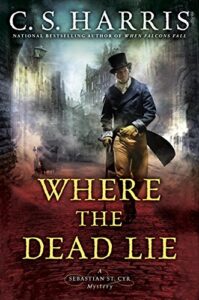By C. S. Harris
 I went through the first 11 St. Cyr mysteries like an alcoholic at happy hour. Then I ran into the classic problem of reading a series: I’d read everything that had been published and had more than a year-long wait for the next book.
I went through the first 11 St. Cyr mysteries like an alcoholic at happy hour. Then I ran into the classic problem of reading a series: I’d read everything that had been published and had more than a year-long wait for the next book.
When Where the Dead Lie came out in April, I couldn’t bring myself to order the book once I learned that it dealt with the torture and rape of children.
What I overlooked is that the great attraction of this series is the courage and commitment to justice that its main characters — Sebastian St. Cyr, his wife Hero, his best friend surgeon Paul Gibson and professional colleagues such as magistrate Sir Henry Lovejoy — and their defense of the vulnerable, the powerless and the defenseless.
This book opens in mid-September 1813, with a one-legged veteran interrupting a furtive burial on the grounds of an abandoned factory. The grave digger and the man in a cart waiting for him escape.
A cursory investigation is done by a local magistrate, who releases the body for burial. A constable, Mott Gowan, not satisfied by the rushed investigation and closure of the case, diverts the body to Paul Gibson. He calls in Sebastian St. Cyr, Viscount Devlin, when he sees the injuries done to the body before death.
The victim, identified as Benji Thatcher, has been living on the streets of London’s Clerkenwell district with his younger sister for the past three years after their mother was deported to Australia’s Botany Bay. Benji’s battered body shows signs of being repeatedly whipped and cut before being strangled. The need to find his missing sister is as urgent as finding his killer.
Sebastian St. Cyr is thrown into a harrowing investigation into the torture and murders of some of London’s many homeless, orphaned children. Often left to fend for themselves when their mothers or fathers are sentenced to deportation to Australia’s Botany Bay or to America, they are vulnerable to being preyed upon by some of the most evil and most untouchable members of London society. He learns more than he cares to about the secret establishments catering to those who enjoy “le vice anglais” and the practices of Marquis de Sade.
As he closes in on the killer (or killers), he discovers that his own niece has been engaged to marry a nobleman with similar twisted tastes.
As Sebastian works through the mystery, he faces the additional challenge of how to bring the perpetrators to justice, when they may be high-ranking and he has meagre proof.
The one element of this book that left me unsatisfied was that it didn’t provide the usual contribution to resolving the mystery of St. Cyr’s origins.
What it does resolve is how and why Sebastian’s father, Lord Hendon, can love and accept him as a son he knows not to be his own by blood. What opens Sebastian’s eyes to his relationship with his father is his relationship with his own son, Simon. When he explores the depths of his love for his infant son, he realizes that if someone told him that Simon wasn’t actually his son, he would not love him less. He realizes the same applies to himself and his father.
If this is the end of the backstory on Sebastian, I’m disappointed. If there’s more to come, I can hardly wait.
There’s more about the previous books in the series and the author here.
#SebastianStCyr


